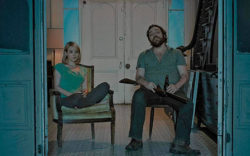It is not apparent that Call Me by Your Name filmmaker Luca Guadagnino and writer David Kajganich (Guadagnino’s A Bigger Splash) get what makes Dario Argento’s 1977 Suspiria such a special horror film. Not exactly known for narrative clarity, in Suspiria, Argento fashioned arguably the most aesthetically striking horror film ever made. Though not ugly, the new Suspiria’s bleak wintry mix never summons the visual strength Argento found in brilliant primary colors.
Beautiful as it is, Suspiria did leave room for improvement, making it a wonderful candidate for a remake. Kajganich smartly keeps the significant touchstones of Argento and Daria Nicolodi’s script, witches and ballet; the remainder is his interpretation. Mennonite refugee Suzy Bannion (Dakota Johnson, who conveys more eroticism in a few dance sequences than in the entirety of three Fifty Shades flicks) runs to 1977 Berlin to join a dance troupe that provides the cover for a coven of witches led by more than one Tilda Swinton. Meanwhile, an aging German psychotherapist, Josef Klemperer (also Swinton, in the film’s biggest miscalculation of several), is searching for his missing patient, a student of the Markos Dance Academy plagued by delusions about witches wanting to possess her.
Guadagnino does not seem to care that he is remaking a landmark of artistic horror. Chilly as the film’s setting is, Suspiria never chills. Only a handful of sequences in the two-and-a-half-hour film deliver the merest notion of horror. Mostly, it is an emotional tale of guilt and loss. An initial viewing deceivingly thrills due to one’s expectation that something awful may be about to happen. It’s hard to believe many viewers will make it to a subsequent viewing by choice, as one now knows what is, or more accurately, is not coming.
Surprisingly, Suspiria’s biggest flaw may be one of its most anticipated features—the soundtrack by Thom Yorke. Claudio Simonetti’s Goblin gifted Argento’s original with one of horror’s most striking scores, yet the only time Yorke’s music is noticeable is when one realizes how little of it one has noticed.
Suspiria fans were bound to struggle with a remake, no matter who made it. (Interestingly, Halloween’s David Gordon Green was initially attached to the film.) Despite a kindred spirit and an abundance of talent, the new movie disappointingly fails to provide a single way it adds to the cumulative viewing experience, and should never be the first version of Suspiria anyone experiences.
Like what you just read? Support Flagpole by making a donation today. Every dollar you give helps fund our ongoing mission to provide Athens with quality, independent journalism.










